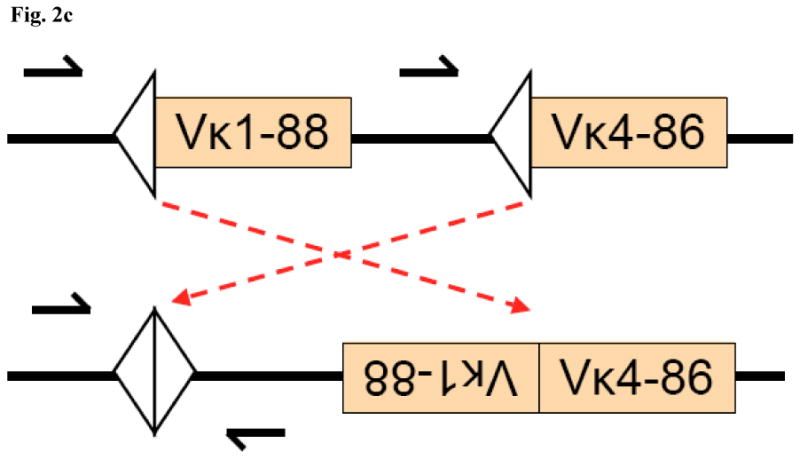Figure 2.



Figure 2a: Conventional Vκ-Jκ rearrangement. A deletional rearrangement of Vκ to Jκ is depicted. The Vκ gene segment is flanked by a 3′ recombination signal sequence with a 12 base pair spacer (12-RSS, white triangle). The Jκ gene segment is flanked by a 5′ recombination signal sequence with a 23 base pair spacer (23-RSS, black triangle). The recombination results in the generation of a coding joint (Vκ-Jκ, on the left) and a signal joint (an episome containing the two fused RSSs, on the right).
Figure 2b: Vκ-Vκ rearrangements may occur by inversion or deletion. Shown are two schematic pairs of Vκ gene segments undergoing either inversional rearrangement (VκA, VκB) or deletional rearrangement (VκC, VκD). Whether Vκ-Vκ rearrangement results in inversion or deletion is dictated by the orientation of the Vκ gene segments. As shown in fig. 1, both deletional and inversional rearrangements are possible, based on the orientations of the Vκ-Vκ pairs in the germline locus. Boxes denote exons, lines introns and white triangles represent 12-RSS.
Figure 2c: Inversional Vκ-Vκ Rearrangement and Signal Joint. Shown is a proposed inversional rearrangement that involves two neighboring Vκ gene segments, Vκ1-88 and Vκ4-86. The signal joint, consisting of two facing 12-RSSs, is retained on the chromosome. The Vκ1-88/Vκ4-86 rearrangement and the corresponding signal joint were amplified and cloned from independent PCR amplifications of spleen DNA from two different mice (see Materials and Methods). The nucleotide sequence of the signal joint is excerpted in fig. 3b (#1) and the full sequence is provided in fig. S1 of the electronic supplement.
